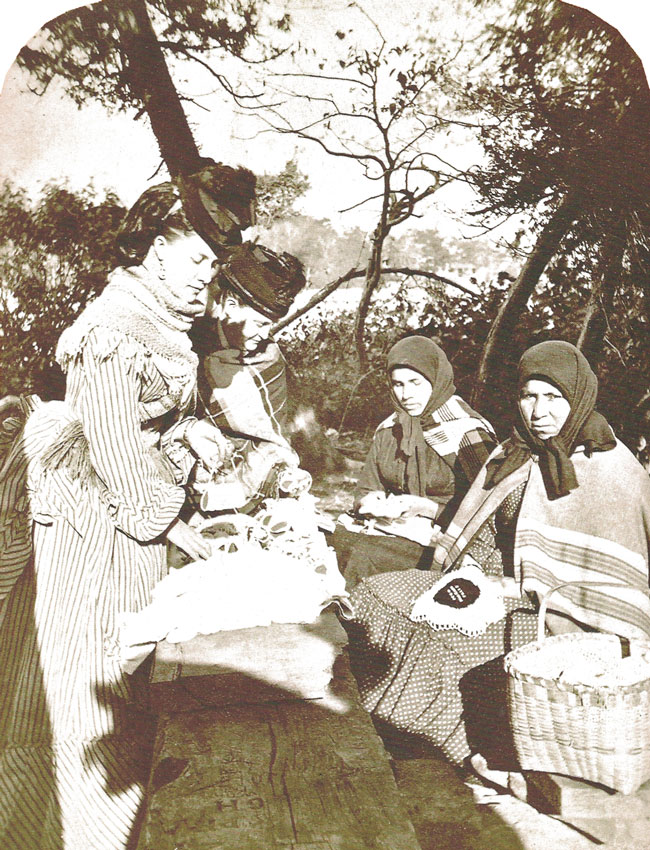Iroquois Beaded Wallet
This wallet is a fine example of Iroquois Indian beadwork dating from the 1840s. It was made by a Tuscarora woman whose people comprise the Sixth Nation of the Iroquois Confederacy, and who resettled from their North Carolina homeland to western New York in the early 1700s. The beadwork artistry of the Tuscarora and their fellow Iroquoians (Seneca, Oneida, Cayuga, Onondaga and Mohawk) is described in two excellent books on Indian beadwork by collector and scholar Gerry Biron: Made of Thunder, Made of Glass: American Indian Beadwork of the Northeast (2006), and A Cherished Curiosity: The Souvenir Beaded Bag In Historic Haudenosaunee (Iroquois) Art (2012).
Biron traces the history of beaded objects that the Iroquois made to sell to non-native Anglos of the middle and upper classes. This exchange began during the earliest years of Iroquois contact with Europeans. Shortly after the first trading post was established in 1608 in Montreal, the Iroquois living in upstate New York were able to obtain cut glass beads imported from Europe. Their traditional arts of adorning hide pouches and clothing with porcupine quills evolved to incorporate the new mediums of beads and fabric.
By the early 1800s, tourism was increasing in the Niagara Falls region near Iroquois lands, with the Tuscarora Reservation being closest to the Falls. This presented an opportunity for the Iroquois to make a subsistence living selling their creations to tourists.
by the early 1840s, the Iroquois had adapted both their beaded designs and the forms of objects they decorated to the Victorian tastes and sensibilities of their customers. Their traditional geometric and organic decorative motifs – curves, spirals, circles and wavy lines – gave way to floral decoration. Biron calls this beadwork the “Niagara floral style” because it was developed largely by Iroquois vendors at Niagara Falls.
Based on Biron’s research, we can date this wallet with good certainty to the mid-1840s. This was the earliest period of the Niagara floral style in which the flowers are round rather than elongated, are smaller, and have longer stems than in later floral designs. Also, the design is bilaterally symmetrical and worked with smaller beads than were used in later designs. The multiple colors of beads – white, blue, ivory, rose, green and gold – are vibrant against the black velvet background.
The pictorial imagery of a bird was also introduced during this time period. Contemporary Tuscarora artists call the bird a Carolina Parakeet, after the now extinct bird that was native to their ancestral North Carolina homeland. Biron says the Iroquois beadwork designers most likely took their cue for the bird motif from Euro-American women’s own needlepoint projects in which it was popular to embellish pincushions, purses and the like with bird imagery.
Iroquois craftswomen were attuned not only to popular design motifs, but also to the types of accessories that would appeal to their non-Native clientele. During the 1840s-50s, both middle and upper class women in the United States emulated fashion trends and customs of the European elite. This type of wallet was made to hold calling cards, the use of which was a form of etiquette adopted from European aristocracy.
The wallet’s interior is lined with a blush color polished cotton that has two pockets sized for holding calling cards, each measuring about 2” x 3.5”. The total length of the open wallet is 8” and the width is 4”.
This is a typical size for a calling card wallet, and is similar in shape and dimensions to two examples in Biron’s collection, shown flanking the center beaded purses.
Iroquois beaded bags (Biron, 2006)
Ladies’ magazines in the 1850s described Niagara beadwork as exotic and desirable accessories. Owning such accessories was a way for Victorian families to demonstrate that they were well bred, widely travelled and highly cultured, as documented in the many photographic portraits that Biron has gathered of well-dressed white women, men and children proudly holding or wearing Iroquois beadwork. Since families typically cherished the Indian beadwork they acquired on their travels, a piece such as this wallet survives in an excellent state of preservation 170 years after its creation.
The woman in this portrait holds a Niagara floral style beaded bag, circa 1850 (reprinted in Biron, 2012)
Although this wallet is stylistically characterized as Niagara beadwork, this particular piece was not necessarily sold at Niagara Falls. The Iroquois, like other Indian tribes throughout the country, migrated to tourist destinations to sell their crafts during the summer months. Iroquois beadwork was thus available at summer resorts and tourist retreats throughout the Northeast where Iroquois families had encampments and sold their work, such as in Lake George, New York and other natural areas that attracted tourists in New Jersey, Virginia, Vermont and Pennsylvania.
From Dress to Decor
In addition to being fashionable dress accessories, Native American beadwork was also valued as an accessory for rustic décor. Virtually all of the traditional Great Camps we’ve visited in the Adirondacks, as well as those documented in period photos, had Native American art adorning the shelves, tables and walls of their interiors. These were beaded objects, clay pots, baskets, weaponry, snow shoes, woven textiles and the like that rusticators had acquired on their travels. Beadwork such as this wallet would be traditionally suited for display in a shadow box among other Native American artwork in a rustic home.
Indian beadwork on the walls and Navajo weavings on the floor in the "Indian Room" at Kamp Kill Kare, circa 1915 (from Adirondack Camps by Craig Gilborn, 2000)
A final, resonant point which Biron makes throughout his books is that Iroquois women accomplished their refined beadwork while living in conditions of “oppressive hardship and poverty.” Insight into the cultural and social context of this artwork only increases our retrospective admiration for the history, ingenuity and talent of these Iroquois artists, and our dedication to continuing to preserve their beadwork legacy.
Tuscarora artist with baby and beadwork, Niagara Falls, circa 1870



























